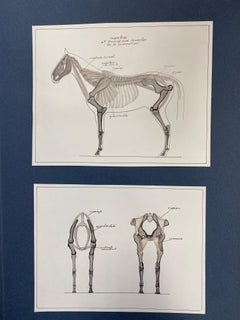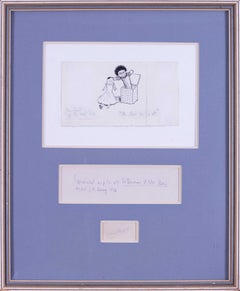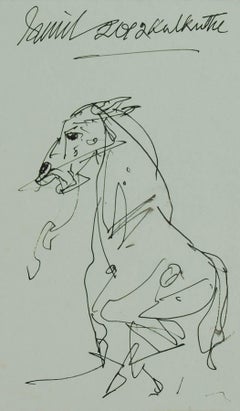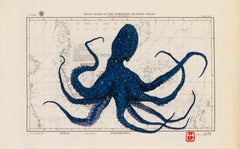Business Card Animal Drawings and Watercolors
to
1
1
1
Overall Width
to
Overall Height
to
2
1
1
287
1,019
843
736
691
404
265
248
212
191
157
143
118
111
111
110
83
77
64
63
1
1
1
1
1
1
2
Art Subject: Business Card
Anatomy Drawings of a Horse - Original French Artwork Equestrian Anatomy Study
By Robert Ladou
Located in Cirencester, Gloucestershire
The Anatomy of a Horse
by Robert Ladou (French 1929-2014)
original drawing stuck on card in blue folder/ thick paper, unframed
top drawing: 7.25 x 9...
Category
20th Century Academic Animal Paintings
Materials
Charcoal, Crayon, Watercolor, Pencil, Color Pencil
British illustration by EH Shephard, illustrator for Winnie the Pooh
Located in Petworth, West Sussex
Ernest Howard Shephard (British, 1879 – 1976)
The land of the lost toys – ‘Oh that’s you is it’
Inscribed with title (lower edge), and further inscribed ...
Category
20th Century English School Animal Drawings and Watercolors
Materials
Paper, Ink, Pen
Related Items
Horse, Drawing, Ink on Paper, Black, Grey by Indian Artist Sunil Das "In Stock"
By Sunil Das
Located in Kolkata, West Bengal
Sunil Das - Horse - 8 x 5 inches (unframed size)
Ink on Paper
( Unframed & Delivered )
Sunil Das was one of India's most important postmodernist painters and rose to prominence thro...
Category
2010s Modern Animal Paintings
Materials
Paper, Ink, Pen
Blue Boy of the North Atlantic - Octopus on Antique Nautical Chart Gyotako Style
By Jeff Conroy
Located in Chicago, IL
A small octopus is inked in the Japanese style of Gyo-Taku print making. Using sumi ink to "print" the octopus, the artist then embellishes it with colored pencil to convey an extraordinary dimensionality. By printing it on a nautical chart, in this case a pilot chart of the Northern Atlantic Ocean from 1945, the artist achieves a beautiful aesthetic. The artwork is unframed. Please contact the gallery for framing options.
Jeff Conroy
Blue Boy of the North Atlantic
sumi ink and colored pencil on mulberry paper
23h x 37w in
58.42h x 93.98w cm
JEC111
Gyotaku - A Japanese word translated from "gyo" meaning fish and "taku" meaning stone impression and is believed to get its inspiration from Chinese stone rubbings of calligraphy, which then gave rise to printing . This tradition dates back to the mid-1800s and was used by fishermen to record their catches, but has also become an art form of its own. Prints were made using Sumi ink and Washi paper. It is rumored that Samurai would settle fishing competitions using Gyotaku prints...
Category
21st Century and Contemporary Contemporary Animal Drawings and Watercolors
Materials
Sumi Ink, Watercolor, Mulberry Paper, Color Pencil
Set of Four Butterflies. French Watercolours on Silk Laid on Handmade Paper.
Located in Cotignac, FR
A set of four watercolours of butterflies on silk, applied to handmade paper, with hand cut edges, by French artist La Roche Laffitte. Two are signed by the artist to the bottom righ...
Category
Mid-20th Century Academic Animal Drawings and Watercolors
Materials
Watercolor, Gouache, Silk, Handmade Paper, Carbon Pencil
H 12.21 in W 15.95 in D 0.04 in
Thomas Sidney Cooper RA, Cow & Sheep In A Landscape
Located in Cheltenham, GB
This charming mid-19th-century watercolour by British artist Thomas Sidney Cooper RA (1803-1902) depicts two sheep and a cow in a landscape. Cooper was a distinguished British painte...
Category
1850s English School Animal Drawings and Watercolors
Materials
Paper, Watercolor
Absinthe Makes The Heart Grow Fonder - Octopus, Gyotaku Style Sumi Ink Painting
By Jeff Conroy
Located in Chicago, IL
A small octopus is inked in the Japanese style of Gyotaku print making. Using sumi ink to "print" the octopus, the artist then embellishes it with colored pencil to convey an extrao...
Category
21st Century and Contemporary Contemporary Animal Drawings and Watercolors
Materials
Sumi Ink, Watercolor, Mulberry Paper, Color Pencil
Joseph Knight, Moorland Landscape With Cattle
Located in Cheltenham, GB
This late 19th-century gouache by British artist Joseph Knight (1837-1909) depicts a gentle moorland landscape with cattle. Knight was primarily known for his naturalistic depictions of North Wales.
Raised amid the hurried industrious streets of Chorlton-Upon-Medlock in Manchester, Knight was obliged to pursue a career at one of its many cotton mills. His father, also Joseph Knight, was a mill engineer and would’ve expected his son to follow suit. It appears he was sent to work at the age of four - unthinkable today, but not uncommon in the 1840s.
In around 1841, Knight was involved in an accident, which resulted in the loss of his right arm. This probably coincided with him being sent, together with his siblings, to stay with relatives, Thomas and Jane Knight, also of Chorlton. Evidently, following this, he undertook a change of direction, taking the first steps on a path to artistry.
During the mid to late 19th century, landscape paintings grew in popularity partly due to the desires of a new middle-class buyer but also as a tonic for increasing urbanisation. And perhaps there’s no better example of an artist who understood the restorative qualities of nature than Joseph Knight.
In his early teens, he gained employment at a photography studio, primarily assisting with portraiture. With a keen eye for composition, his skills flourished and were met with much approval from staff and customers alike. It was here that he first met with Mr. Henry Crowley who was so taken by the boy’s aptitude that he encouraged him to seek a career as a painter. Crowley funded his education, enrolling him at the Manchester Academy of Fine Arts, where the emphasis was on honing one’s draughtsmanship in a strict environment via diligent study and life drawing.
With his technique now evolved, commissions were forthcoming - both as a painter and photographer. In the 1861 census, now married, he records his occupation as ‘Photographic artist and painter in oil’. It’s plausible that he was involved in adding tints to photographic portraits during this period while also working as a painter.
As recognition of his development, in 1868, he was elected as a full member of the Manchester Academy of Fine Arts, and a year later debuted at London’s Royal Academy with ‘Evening, Near Quimper, Brittany’ and ‘Breton Peasants’. It was around this time that he came to the attention of several of his younger contemporaries who viewed his naturalistic approach as altogether fresher and entirely modern. In a quiet rebellion against their formulaic training, they undertook to paint directly from nature, ‘en plein air’, without the rigour of academic constraints. The group, which included Joshua Anderson Hague...
Category
1890s English School Landscape Drawings and Watercolors
Materials
Paper, Gouache
The Great Australian Bight Trio - Gyotaku Style Sumi Ink Painting of an Octopus
By Jeff Conroy
Located in Chicago, IL
A small octopus is inked in the Japanese style of Gyo-Taku print making. Using sumi ink to "print" the octopi, the artist then embellishes them with colored pencil to convey an extraordinary dimensionality. By printing them on an antique nautical chart...
Category
21st Century and Contemporary Contemporary Animal Drawings and Watercolors
Materials
Sumi Ink, Watercolor, Color Pencil
Farm Horse Drinking
Located in Fairlawn, OH
Farm Horse Drunking
Charcoal and pastel on artist's board, c. 1920
Signed lower right in pencil (see photo)
Titled in ink lower center, as are all the illustration for At the Farm (s...
Category
1920s English School Animal Drawings and Watercolors
Materials
Chalk
1930's English Dog Painting Wire Fox Terrier Puppies Waiting to be Fed Signed
Located in Cirencester, Gloucestershire
'Waiting for Supper'
Wire Fox terrier puppies
English School, indistinctly signed with monogram
dated 1936
watercolour painting on artist paper, framed
Glass covering
framed: 13.5 x ...
Category
Early 20th Century English School Animal Paintings
Materials
Watercolor
Pigs on a Trolley - Vintage Picture Book Two-Page Spread Illustration
Located in Soquel, CA
Pigs on a Trolley - Vintage Picture Book Two-Page Spread Illustration
A two-page spread in India ink pen and watercolor by Irene Pattinson (Ameri...
Category
1950s American Modern Figurative Drawings and Watercolors
Materials
Paper, India Ink, Watercolor, Pen
H 17 in W 30 in D 0.25 in
Boo Berry - Gyotaku Style Sumi Ink Painting of a Multi-Colored Octopus
By Jeff Conroy
Located in Chicago, IL
A small octopus is inked in the Japanese style of Gyo-Taku print making. Using sumi ink to "print" the octopus, the artist then embellishes it with colored pencil to convey an extraordinary dimensionality. By printing it on Mulberry paper, which mimics the swirl of water, the artist achieves a beautiful aesthetic. The artwork is unframed. Please contact the gallery for framing options.
Jeff Conroy
Boo Berry
sumi ink and colored pencil on mulberry paper
12.50h x 18.25w in
31.75h x 46.35w cm
JEC116
Gyotaku - A Japanese word translated from "gyo" meaning fish and "taku" meaning stone impression and is believed to get its inspiration from Chinese stone rubbings...
Category
21st Century and Contemporary Contemporary Animal Drawings and Watercolors
Materials
Sumi Ink, Watercolor, Mulberry Paper, Color Pencil
Cobalt Canary - Gyotaku Style Sumi Ink Painting, Multi-Colored Octopus, Framed
By Jeff Conroy
Located in Chicago, IL
A small octopus is inked in the Japanese style of Gyo-Taku print making. Using sumi ink to "print" the octopus, the artist then embellishes it with colored pencil to convey an extraordinary dimensionality. By printing it on Mulberry paper, which mimics the swirl of water, the artist achieves a beautiful aesthetic. The artwork is matted and framed in a white wooden frame measuring 18.25h x 24.25w x 1d inches.
Jeff Conroy
Cobalt Canary
sumi ink and colored pencil on mulberry paper
12.50h x 18.25w in
31.75h x 46.35w cm
JEC122
Gyotaku - A Japanese word translated from "gyo" meaning fish and "taku" meaning stone impression and is believed to get its inspiration from Chinese stone rubbings...
Category
21st Century and Contemporary Contemporary Animal Drawings and Watercolors
Materials
Sumi Ink, Watercolor, Mulberry Paper, Color Pencil



